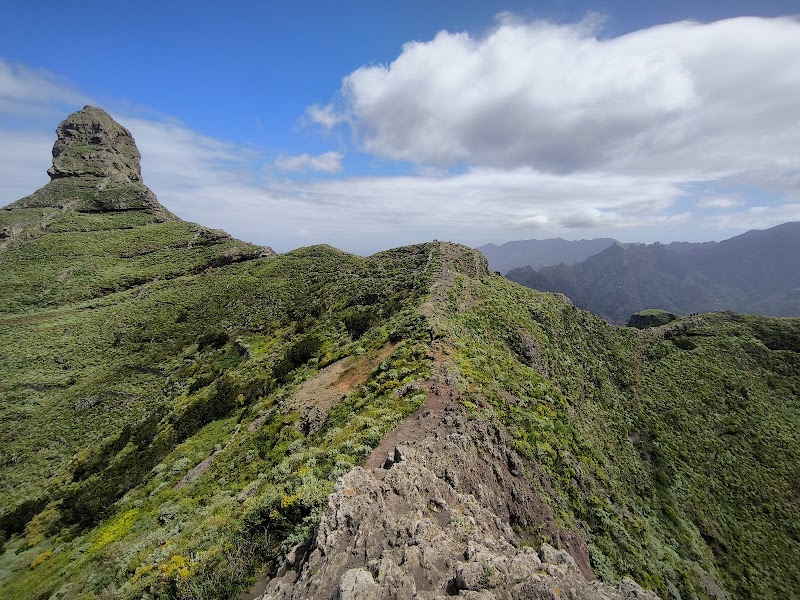
Pilgrimage and Celebration: The Virgin of Guadalupe Festival in San Sebastián, Canary Islands
Experience the Virgin of Guadalupe Festival in San Sebastián, La Gomera, where hiking meets heritage. Traverse forested paths to a sacred hermitage while immersing in vibrant local culture, tradition, and breathtaking island views.
Wear Grippy Footwear
The pilgrimage trail shifts quickly from smooth town cobblestones to loose volcanic gravel, so sturdy shoes with good traction will keep you steady.
Bring Adequate Water
Hydration sources are scarce; carry at least 1.5 liters to stay comfortable through the moderate 7km hike.
Dress in Layers
Mornings start cool, but elevation and sun bring heat—light layers let you adjust on the move easily.
Start Early
The trek can take 2 to 3 hours round trip; starting before mid-morning avoids midday heat and gives better photo light.
Pilgrimage and Celebration: The Virgin of Guadalupe Festival in San Sebastián, Canary Islands
Each year, San Sebastián on La Gomera—the smallest of the Canary Islands—transforms into a vibrant stage for the Virgin of Guadalupe Festival. This event is more than a religious gathering; it’s a celebration that intertwines history, culture, and the island’s natural pulse. Visitors and locals embark on the pilgrimage route from the town to the Hermitage of Virgen de Guadalupe, set at an elevation where the winds speak and the views hold the Atlantic’s endless reach.
The festival’s heart beats with processions, traditional music, and dancing, where islanders in striking costume bring centuries-old customs to life. The trail leading to the hermitage measures about 7 kilometers round trip, ascending approximately 350 meters. It cuts through laurel forests that brush with mist and echo with the calls of native birds. The terrain varies from smooth cobblestones in town to rugged volcanic soil higher up, demanding sturdy shoes and steady footing.
Outdoor enthusiasts find this pilgrimage a clear narrative of challenge and reward. The ascent is moderate but persistent. The forest, composed of gumwoods and towering laurel trees, seems to reach toward you, as if inviting conversation while sheltering against the island's midday sun. When you break the tree line near the hermitage, the wind pushes with renewed energy, daring you to pause and watch the vast Atlantic’s waves chase light beneath the glowing sky.
Timing your journey is crucial. The festival often falls in early September, when the climate is forgiving but still warm enough to accompany a steady sweat. Hydrate ahead and carry water; springs along the route are few and unreliable. Layers are wise—mornings start cool, but once the sun claims the sky, temperatures can rise quickly. Waterproof shoes with good grip will handle cobblestones on the approach and the often loose volcanic gravel by the summit.
Beyond the hike, the festival is a chance to engage with La Gomera’s fiercely independent spirit. Artisans line the plaza selling traditional crafts—pottery, woven baskets, and local honey. The music mingles with the island’s rhythm, inviting even the casual visitor to join in the dance steps that pulse through the night.
This festival isn’t a mere spectacle; it’s a lived experience. The Virgin’s feast day pulls communities to the paths and the peaks, transforming ordinary routes into spirited passages. Whether you come for the hike or the heritage, the Virgin of Guadalupe Festival offers a journey into the rugged heart of San Sebastián and the Canary Islands’ enduring traditions.
Nearby Trips
All Adventures
Boat Charters
Water Activities
Adventures near San Sebastián, Canary Islands
Discover the unique and memorable adventures that make San Sebastián, Canary Islands special.
Frequently Asked Questions
What is the historical significance of the Virgin of Guadalupe Festival in San Sebastián?
The festival honors the Virgin of Guadalupe, La Gomera's patron saint, uniting islanders in religious devotion and cultural celebration that dates back to the 16th century.
Are there any alternative viewpoints during the pilgrimage hike?
Yes, midway through the ascent near the Corona forestal, small clearings offer stunning vistas toward San Sebastián bay and the sprawling Atlantic, often overlooked by casual pilgrims.
What kind of wildlife might I encounter on the trail?
The laurel forest is home to endemic birds like the Tenerife Blue Chaffinch and the La Gomera Giant Lizard, which may scatter across sunlit rocks if approached quietly.
Is the pilgrimage route suitable for children and seniors?
The path is moderate and manageable for active families and seniors used to walking, but care is advised on uneven stretches and during hot weather.
How does the festival impact the local environment?
While the festival attracts many visitors, local authorities enforce strict waste management and trail preservation protocols to minimize environmental stress during peak periods.
What photography opportunities does the festival offer?
Early morning light enhances the rustic chapel’s facades and the forest’s misty shadows; the sunset from the hermitage reveals splendid panoramas across the ocean and island contours.
Recommended Gear
Hiking shoes with good grip
Provides stability on mixed terrain from cobblestone to volcanic gravel.
Water bottle (1.5+ liters)
Critical for hydration, especially during warm months when refreshment points are limited.
Layered clothing
Allows comfortable adjustment to temperature shifts during early mornings and midday.
Sun protection (hat, sunscreen)
Shields exposed skin from strong island sun, reducing heat stress.
Local Insights
Hidden Gems
- "Small caves along the trail that were once used by hermits"
- "The lesser-known 'La Fortaleza' viewpoint, a short detour with vast ocean views"
Wildlife
- "Tenerife Blue Chaffinch"
- "La Gomera Giant Lizard"
- "Various endemic plant species adapted to misty laurel forests"
History
"The festival merges indigenous Guanche beliefs with Christian traditions, celebrating the Virgin whose image was reportedly discovered in a local cave, linking spiritual and natural heritage."
